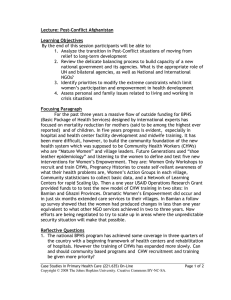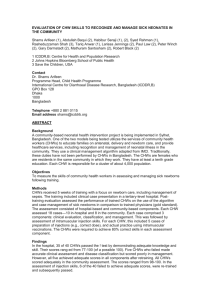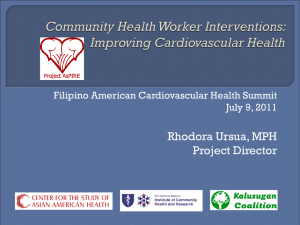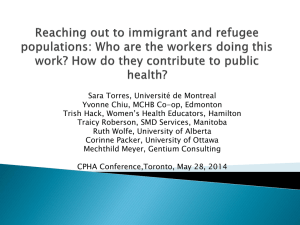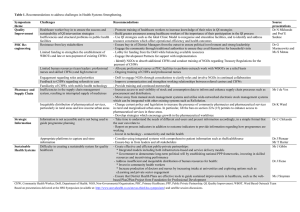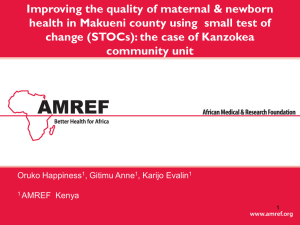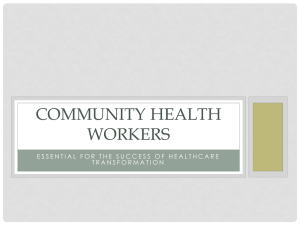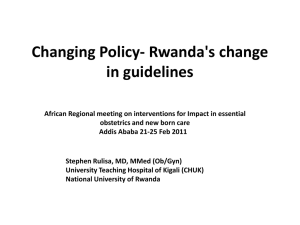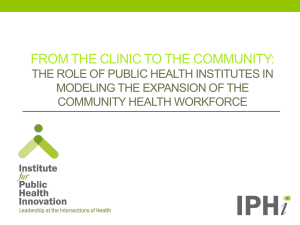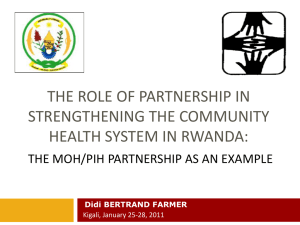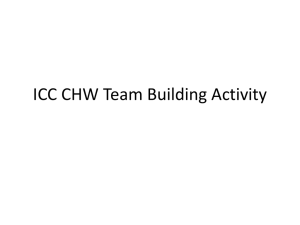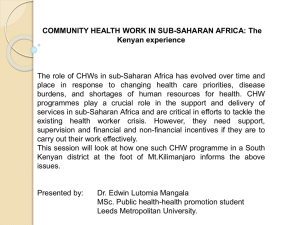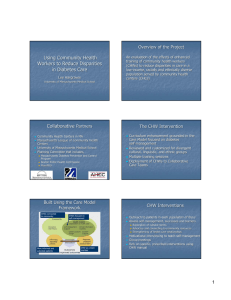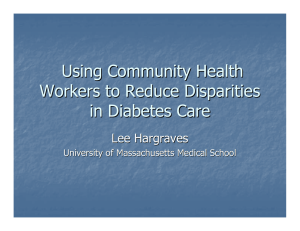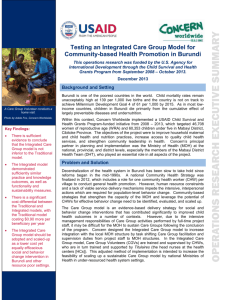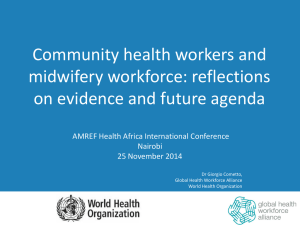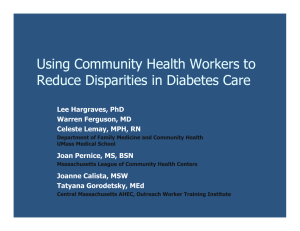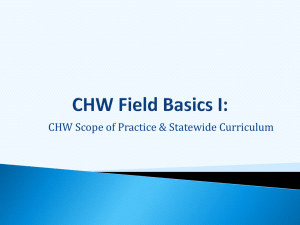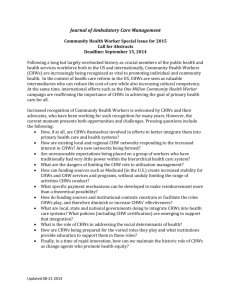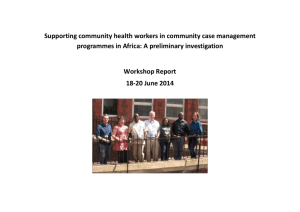Community health best practices in Rwanda
advertisement
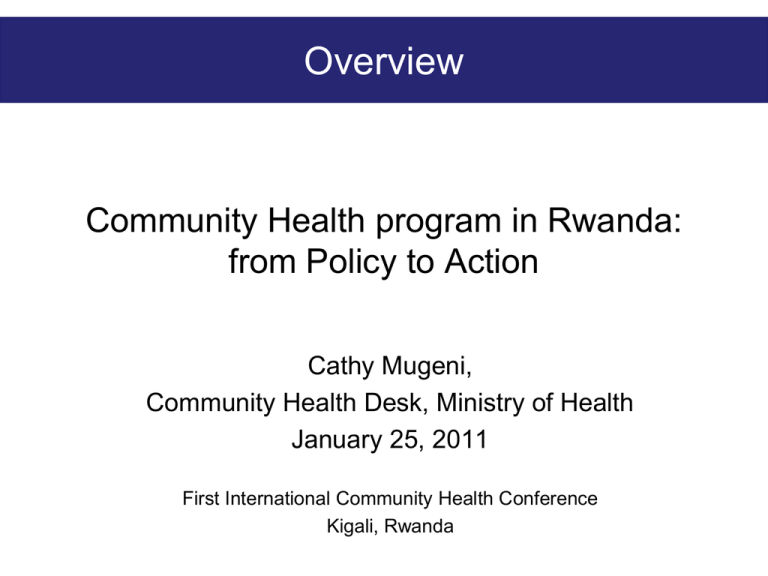
Overview Community Health program in Rwanda: from Policy to Action Cathy Mugeni, Community Health Desk, Ministry of Health January 25, 2011 First International Community Health Conference Kigali, Rwanda Rwanda National Health Policy (based on WHO’s seven building blocks health systems strengthening) 1 1 2 2 To improve accessibility to, quality of and demand for Maternal Health, Family Plan., Rep. Health, Nutrition services 3 To consolidate, To consolidate, expand and improve expand and improve services for the services for the prevention of disease treatment and and promotion of control of disease health To strengthen the sector’s institutional capacity To increase the availability and quality of human resources for Health To ensure financial accessibility to health services for all 3 4 5 6 To ensure financial accessibility to health services for all & sustainable & equitable financing of the health sector To ensure geographical accessibility to health services for all To ensure (universal) availability & rational use at all levels of quality drugs, vaccines & consumables To ensure the highest attainable quality of health services at all levels 7 To strengthen Specialised Services, National Referral Hospitals and research capacity Levels of Intervention •Family-oriented community based services •Population oriented schedulable services •Individual oriented clinical services Community Health Structure NATIONAL LEVEL MiniSante Community Health Desk DISTRICT ADMINISTRATION District Health Supervisor • • DISTRICT HOSPITAL District Hygiene and Sanitation Officer Community Health Coordinator HEALTH CENTER/COOPERATIVE Hygienist or Sociologue Chargé of Community Health Activities CELL LEVEL Binome Supervisor (1 per cell, elected from among the binomes) • • • • UMUDUGUDU (VILLAGE) LEVEL Community Health Workers Binomes (male & female worker in each umudugudu) CAS (1 per umudugudu) ASM (1 per umudugudu) Palliative Care (2 per umudugudu, not yet elected) T Strengthening health systems through community health Evolution of CHWs 1995 BEGINNING OF CHW • Initiated : 1995 ( after Genocide ) Objective: first level of entry to the health system • Operates at smallest administrative unit of the country (villages) • Includes a minimum package of activities focusing on primary health care +11% p.a. 2005 2011 Evolution • Selection and training of CHWs countrywide • Linkage to a diversification of strategies • to reduce child and maternal mortality • community case management Community Health Workers 1 Female in charge of maternal Health 1 CHSA (in charge of social affairs) 1 Binome female & male 4 CHWs/ village Community Health Workers have broadof of Community Health Workers: a abroad ofrange activities Community Health Workers have broadarange range activities activities Preventive Services Curative Services •Community sensitization •Community Case on prevention of common: diseases: malaria, diarrhoea, ARI, etc. • Education for prevention of sexual transmitted infections •Community mobilization and sensitization, health campaign on hygiene and sanitation, immunization etc. •Educate communities on use of water treatment solutions and distribute them Management of malaria, ARI, diarrhoea, vaccination, malnutrition (e.g. Community Integrated Management of Childhood Illnesses/Community IMCI) •Provision of family planning services including FP products •Engage in community DOTs for tuberculosis, HIV Promotive Services •Nutrition education to communities •Growth monitoring particularly among children under five years old •Nutrition surveillance •Routine home visits for active case finding Community-based prevention, screening and treatment of malnutrition • Monthly growth monitoring & promotion • Screening children for SAM using Middle Arm Circumference Measurement tape (MUAC) • Treatment of SAM with RUTF (Plumpynut) • Community demonstration kitchens to prevent malnutrition and reoccurrence • Community level follow-up for treatment effectiveness Community based Integrated Management of Child Illness (CB-IMCI) • Targets children less than 5 years for following health problems • fever • diarrhea • acute respiratory infections • malnutrition • Medications provided include; • coartem • amoxicillin (pneumonia) • oral rehydration solution + zinc Community-based maternal- neonatal care • Identify and register women of reproductive age (encourage family planning) • Identify pregnant women and encourage ANC, birth preparedness and facility based deliveries • Identify women and newborns with danger signs and refer them to health facility for care • Accompany women in labor to health facilities • Encourage early postnatal facility checks for both newborns and the mothers • Use RapidSMS to support activities Community based provision of family planning • Community health workers (CHW) provide: • condoms, • oral contraceptive pills, • injectables, • Standard Days Method • Pilot In March and April, 2010, • 3068 CHWs were trained as trainers in CBP. Community DOT HIV, TB and other chronic illnesses Community DOTs for treatment and care of TB; • implemented in 30 districts • 100% of the Rwandan population Community DOTs for treatment and care • HIV • NCD implemented by partners in 3 districts since 2005 Community behavior change and communication • Sensitizing communities on disease preventive measures • proper hygiene and sanitation, • use of Insecticide treated mosquito nets, • early health care seeking behaviors, • breast feeding, infant and young child feeding/nutrition • Disease surveillance • Contact tracing Community Environmental Health Interventions: Implementation of CBEHPP • CHWs will be responsible for mobilizing the community to join CHC • CHWs will facilitate for the CHC during dialogue sessions • The CHWs will list all CHC members in a registration book • CHW signs membership cards for those attending sessions • CHWs make household visits to check improved hygiene practices Community health information systems and innovative technologies (m’ubuzima: Rapid SMS & P4H ) • All CHWs received mobile phones; • Phone4He being piloted for CHWs to report on HMIS indicators • CHW binome enters list of community health indicators that feeds into national HMIS; • 22 indicators • include CCM, MCH, deaths, • Rapid SMS transmits information into computerized recording and response system • Improves referral system • Contact tracing, etc • Facilitates emergency services / Community-based health insurance • Health mutuelle: • Covers 85% of population • 1000Rwf annual fee, • payment per service • Increases access to health facility services • Reduction in illnesses • Most vulnerable are covered by basket fund (risk-pooling) Community-PBF/www.pbfrwanda.org/siscom Improves performance of CHWs by motivating them to raise agreed upon performance indicators Payments made when proof of the agreed level of performance Community PBF guide details management at different levels The Sector Steering Committee oversees the implementation and approves payment to the CHW Cooperative. Indicators entered at district level into web-based database after quarterly approval by committee with feedback CHWs COOPERATIVEs All CHWs organized in cooperatives to ensure income generation and accountability of expected results Community PBF payments used for cooperative income generating projects including: poultry, cattle/goat/pig rearing, crop farming, basket making, etc. Incentives and motivation for CHWs • Trust and respect from community members, leaders etc… • Support from Supervisors and implementation partners help improve work; • Regular trainings, meetings supervision • In-country study tours to learn from peers in other districts • Distance learning • Community performance-based financing (PBF); • Membership in cooperatives for income generation Monitoring and Evaluation National • M&E desk at MoH: supervisors • M&E technical work group with partners District • 41 & 5 NGOs Community health and M&E supervisors Health center • 380 In-charge of community health • 416 Sector-level comité de pilotage Cell • CHW supervisors Way forward • • • • • Evaluate innovative interventions Community participation Promote and share best practices Learn from other country experiences Strengthen referral between community and health facilities • More… THANKS
